Strategic Management of Emirates
VerifiedAdded on 2023/01/19
|16
|3917
|66
AI Summary
This report provides a comprehensive analysis of the strategic management of Emirates, including a brief summary, analysis of vision, PESTEL analysis, Porter's five forces, leadership strategy, and more. It explores the challenges faced by Emirates in the aviation industry and discusses their cost leadership strategy. The report also examines the primary and support activities of Emirates' value chain and highlights the tangible and intangible resources that contribute to their organizational capability.
Contribute Materials
Your contribution can guide someone’s learning journey. Share your
documents today.

STRATEGIC
MANAGEMENT
MANAGEMENT
Secure Best Marks with AI Grader
Need help grading? Try our AI Grader for instant feedback on your assignments.
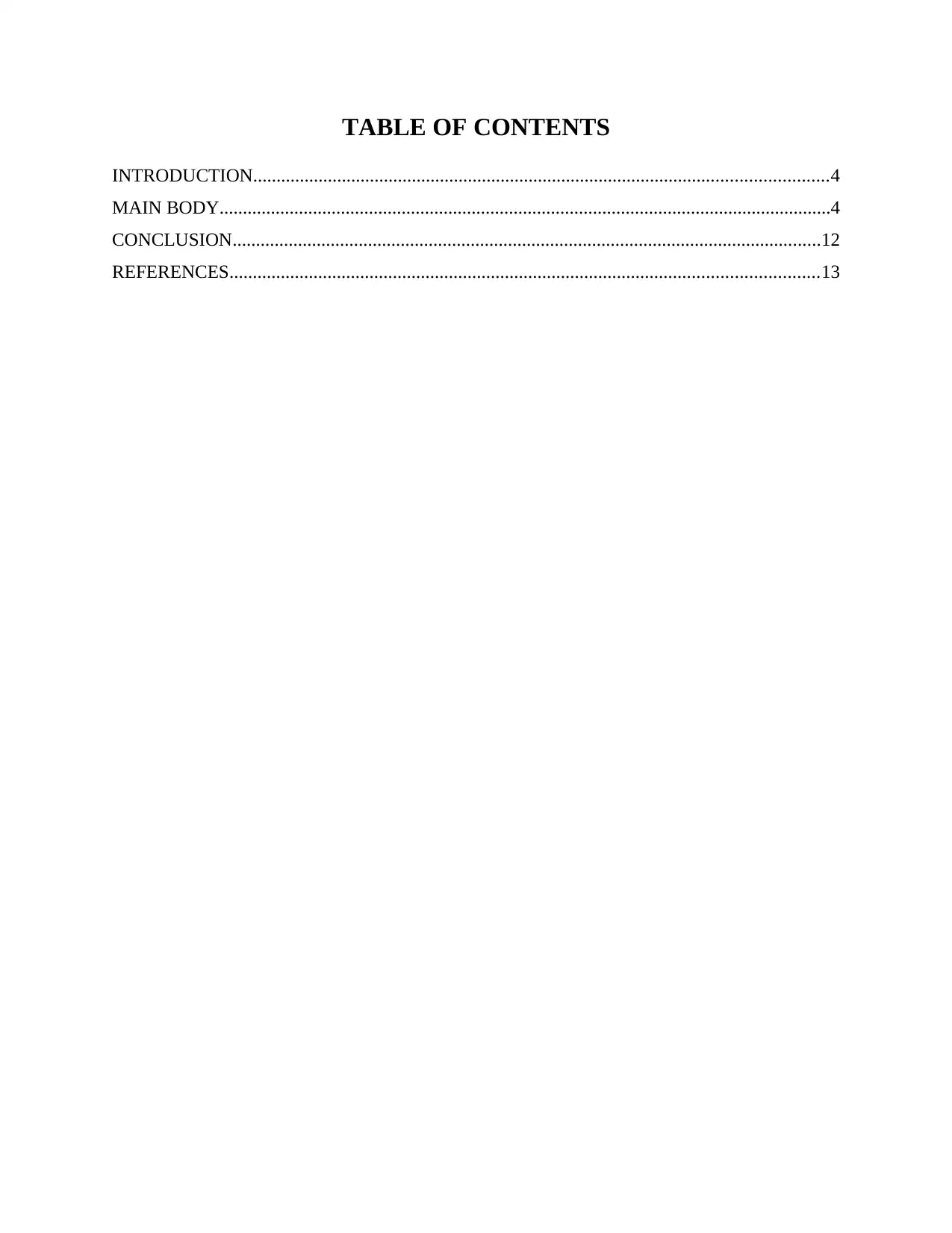
TABLE OF CONTENTS
INTRODUCTION...........................................................................................................................4
MAIN BODY...................................................................................................................................4
CONCLUSION..............................................................................................................................12
REFERENCES..............................................................................................................................13
INTRODUCTION...........................................................................................................................4
MAIN BODY...................................................................................................................................4
CONCLUSION..............................................................................................................................12
REFERENCES..............................................................................................................................13

INTRODUCTION
Strategic management is basically the planning, monitoring as well as assessment of the
necessary resources which are required for meeting the goals and objectives of organizations.
Emirates is predominately the airline which is based in Dubai, United Arab and is the subsidiary
group of Emirates groups. It was established in 1985 and is possessed by Dubai government
along with operating in more than 140 cities as well as 80 countries.
This report addresses brief summary of Emirates, Analysis of vision, PESTEL analysis of
Emirates, Porter's five forces of Emirates, Implications for new entrant, Leadership strategy of
Emirates, Primary as well as support activities of Emirates, Tangible, intangible sources and
organizational capability, VRIN framework of Emirates and Effectiveness of leadership strategy.
MAIN BODY
Brief summary of Emirates
Emirates is one of the renowned airline in the Middle east and has served the customers
from decades. No airline has developed like Emirates in the past few years which has eventfully
mad them the leading transporter of various passengers across the international routes. Emirates
together with Qatar as well as Etihad airways managed to restructure the world map thus
transforming the international travel hub from Europe to Middle East. Emirates recently holds
around 75 million passengers ever year and thus have become the busiest airport. Along with
this, it has a well structure force of about 18000 flight attendants who are able to interact with the
passengers in about 50 languages.
The remarkable growth of the Emirates is due to Tim Clark who is involved in route
planning and thus took the advantage of Boeing 777 along with Airbus A380 which are the
renowned transporters. It generally serves more than 11 destinations and thus took a drastic turn
in 2008 in terms of growth (Ansoff and et.al.,2018). Emirate provides its customers with the
unforgettable experience by offering entertainment television, along with quality food which the
airline provides to its passengers, Besides this, it consists of around 600 multilingual members in
welcome team known by the name Marhaba which in Arabic means welcome and thus help all
the passenger from first class to business class in their arrival and departure. Apart from this,
Emirates have created a special facility state-of-the-art bin order to provide training to their
employees from checking them to serving them better. Airline normally offers a crew training
programme at no expense for seven weeks wherein each new hire are allowed to function in
Strategic management is basically the planning, monitoring as well as assessment of the
necessary resources which are required for meeting the goals and objectives of organizations.
Emirates is predominately the airline which is based in Dubai, United Arab and is the subsidiary
group of Emirates groups. It was established in 1985 and is possessed by Dubai government
along with operating in more than 140 cities as well as 80 countries.
This report addresses brief summary of Emirates, Analysis of vision, PESTEL analysis of
Emirates, Porter's five forces of Emirates, Implications for new entrant, Leadership strategy of
Emirates, Primary as well as support activities of Emirates, Tangible, intangible sources and
organizational capability, VRIN framework of Emirates and Effectiveness of leadership strategy.
MAIN BODY
Brief summary of Emirates
Emirates is one of the renowned airline in the Middle east and has served the customers
from decades. No airline has developed like Emirates in the past few years which has eventfully
mad them the leading transporter of various passengers across the international routes. Emirates
together with Qatar as well as Etihad airways managed to restructure the world map thus
transforming the international travel hub from Europe to Middle East. Emirates recently holds
around 75 million passengers ever year and thus have become the busiest airport. Along with
this, it has a well structure force of about 18000 flight attendants who are able to interact with the
passengers in about 50 languages.
The remarkable growth of the Emirates is due to Tim Clark who is involved in route
planning and thus took the advantage of Boeing 777 along with Airbus A380 which are the
renowned transporters. It generally serves more than 11 destinations and thus took a drastic turn
in 2008 in terms of growth (Ansoff and et.al.,2018). Emirate provides its customers with the
unforgettable experience by offering entertainment television, along with quality food which the
airline provides to its passengers, Besides this, it consists of around 600 multilingual members in
welcome team known by the name Marhaba which in Arabic means welcome and thus help all
the passenger from first class to business class in their arrival and departure. Apart from this,
Emirates have created a special facility state-of-the-art bin order to provide training to their
employees from checking them to serving them better. Airline normally offers a crew training
programme at no expense for seven weeks wherein each new hire are allowed to function in
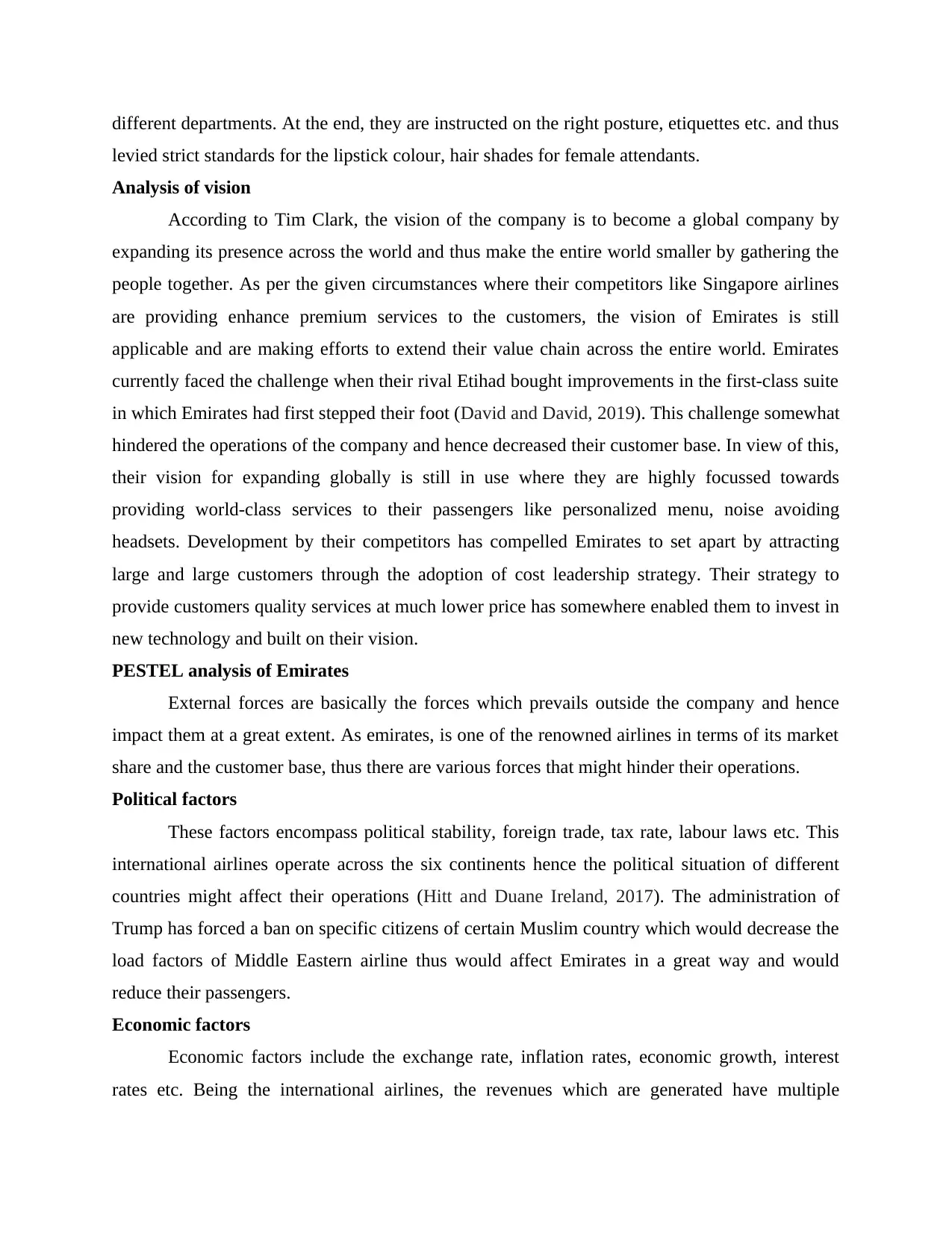
different departments. At the end, they are instructed on the right posture, etiquettes etc. and thus
levied strict standards for the lipstick colour, hair shades for female attendants.
Analysis of vision
According to Tim Clark, the vision of the company is to become a global company by
expanding its presence across the world and thus make the entire world smaller by gathering the
people together. As per the given circumstances where their competitors like Singapore airlines
are providing enhance premium services to the customers, the vision of Emirates is still
applicable and are making efforts to extend their value chain across the entire world. Emirates
currently faced the challenge when their rival Etihad bought improvements in the first-class suite
in which Emirates had first stepped their foot (David and David, 2019). This challenge somewhat
hindered the operations of the company and hence decreased their customer base. In view of this,
their vision for expanding globally is still in use where they are highly focussed towards
providing world-class services to their passengers like personalized menu, noise avoiding
headsets. Development by their competitors has compelled Emirates to set apart by attracting
large and large customers through the adoption of cost leadership strategy. Their strategy to
provide customers quality services at much lower price has somewhere enabled them to invest in
new technology and built on their vision.
PESTEL analysis of Emirates
External forces are basically the forces which prevails outside the company and hence
impact them at a great extent. As emirates, is one of the renowned airlines in terms of its market
share and the customer base, thus there are various forces that might hinder their operations.
Political factors
These factors encompass political stability, foreign trade, tax rate, labour laws etc. This
international airlines operate across the six continents hence the political situation of different
countries might affect their operations (Hitt and Duane Ireland, 2017). The administration of
Trump has forced a ban on specific citizens of certain Muslim country which would decrease the
load factors of Middle Eastern airline thus would affect Emirates in a great way and would
reduce their passengers.
Economic factors
Economic factors include the exchange rate, inflation rates, economic growth, interest
rates etc. Being the international airlines, the revenues which are generated have multiple
levied strict standards for the lipstick colour, hair shades for female attendants.
Analysis of vision
According to Tim Clark, the vision of the company is to become a global company by
expanding its presence across the world and thus make the entire world smaller by gathering the
people together. As per the given circumstances where their competitors like Singapore airlines
are providing enhance premium services to the customers, the vision of Emirates is still
applicable and are making efforts to extend their value chain across the entire world. Emirates
currently faced the challenge when their rival Etihad bought improvements in the first-class suite
in which Emirates had first stepped their foot (David and David, 2019). This challenge somewhat
hindered the operations of the company and hence decreased their customer base. In view of this,
their vision for expanding globally is still in use where they are highly focussed towards
providing world-class services to their passengers like personalized menu, noise avoiding
headsets. Development by their competitors has compelled Emirates to set apart by attracting
large and large customers through the adoption of cost leadership strategy. Their strategy to
provide customers quality services at much lower price has somewhere enabled them to invest in
new technology and built on their vision.
PESTEL analysis of Emirates
External forces are basically the forces which prevails outside the company and hence
impact them at a great extent. As emirates, is one of the renowned airlines in terms of its market
share and the customer base, thus there are various forces that might hinder their operations.
Political factors
These factors encompass political stability, foreign trade, tax rate, labour laws etc. This
international airlines operate across the six continents hence the political situation of different
countries might affect their operations (Hitt and Duane Ireland, 2017). The administration of
Trump has forced a ban on specific citizens of certain Muslim country which would decrease the
load factors of Middle Eastern airline thus would affect Emirates in a great way and would
reduce their passengers.
Economic factors
Economic factors include the exchange rate, inflation rates, economic growth, interest
rates etc. Being the international airlines, the revenues which are generated have multiple
Secure Best Marks with AI Grader
Need help grading? Try our AI Grader for instant feedback on your assignments.
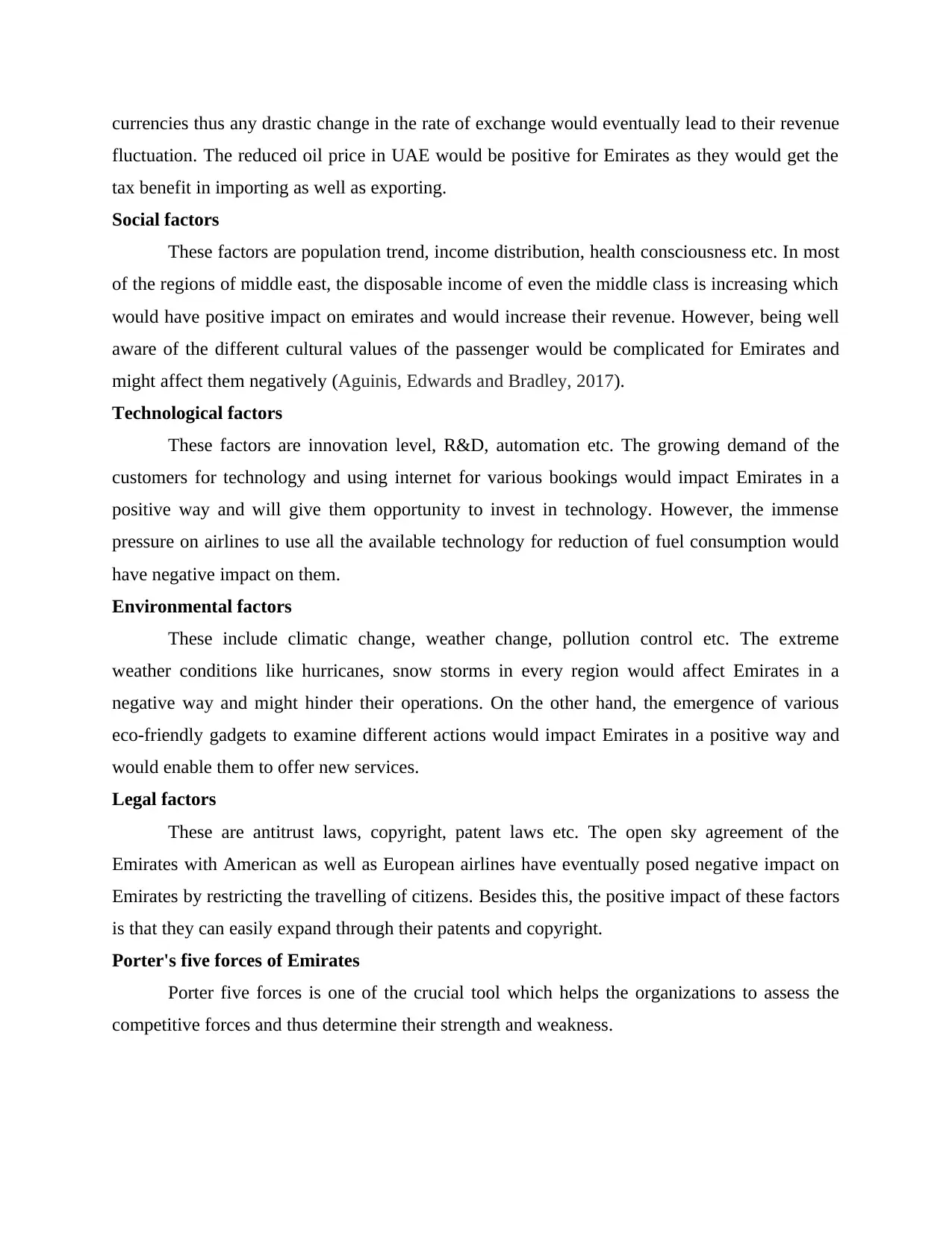
currencies thus any drastic change in the rate of exchange would eventually lead to their revenue
fluctuation. The reduced oil price in UAE would be positive for Emirates as they would get the
tax benefit in importing as well as exporting.
Social factors
These factors are population trend, income distribution, health consciousness etc. In most
of the regions of middle east, the disposable income of even the middle class is increasing which
would have positive impact on emirates and would increase their revenue. However, being well
aware of the different cultural values of the passenger would be complicated for Emirates and
might affect them negatively (Aguinis, Edwards and Bradley, 2017).
Technological factors
These factors are innovation level, R&D, automation etc. The growing demand of the
customers for technology and using internet for various bookings would impact Emirates in a
positive way and will give them opportunity to invest in technology. However, the immense
pressure on airlines to use all the available technology for reduction of fuel consumption would
have negative impact on them.
Environmental factors
These include climatic change, weather change, pollution control etc. The extreme
weather conditions like hurricanes, snow storms in every region would affect Emirates in a
negative way and might hinder their operations. On the other hand, the emergence of various
eco-friendly gadgets to examine different actions would impact Emirates in a positive way and
would enable them to offer new services.
Legal factors
These are antitrust laws, copyright, patent laws etc. The open sky agreement of the
Emirates with American as well as European airlines have eventually posed negative impact on
Emirates by restricting the travelling of citizens. Besides this, the positive impact of these factors
is that they can easily expand through their patents and copyright.
Porter's five forces of Emirates
Porter five forces is one of the crucial tool which helps the organizations to assess the
competitive forces and thus determine their strength and weakness.
fluctuation. The reduced oil price in UAE would be positive for Emirates as they would get the
tax benefit in importing as well as exporting.
Social factors
These factors are population trend, income distribution, health consciousness etc. In most
of the regions of middle east, the disposable income of even the middle class is increasing which
would have positive impact on emirates and would increase their revenue. However, being well
aware of the different cultural values of the passenger would be complicated for Emirates and
might affect them negatively (Aguinis, Edwards and Bradley, 2017).
Technological factors
These factors are innovation level, R&D, automation etc. The growing demand of the
customers for technology and using internet for various bookings would impact Emirates in a
positive way and will give them opportunity to invest in technology. However, the immense
pressure on airlines to use all the available technology for reduction of fuel consumption would
have negative impact on them.
Environmental factors
These include climatic change, weather change, pollution control etc. The extreme
weather conditions like hurricanes, snow storms in every region would affect Emirates in a
negative way and might hinder their operations. On the other hand, the emergence of various
eco-friendly gadgets to examine different actions would impact Emirates in a positive way and
would enable them to offer new services.
Legal factors
These are antitrust laws, copyright, patent laws etc. The open sky agreement of the
Emirates with American as well as European airlines have eventually posed negative impact on
Emirates by restricting the travelling of citizens. Besides this, the positive impact of these factors
is that they can easily expand through their patents and copyright.
Porter's five forces of Emirates
Porter five forces is one of the crucial tool which helps the organizations to assess the
competitive forces and thus determine their strength and weakness.
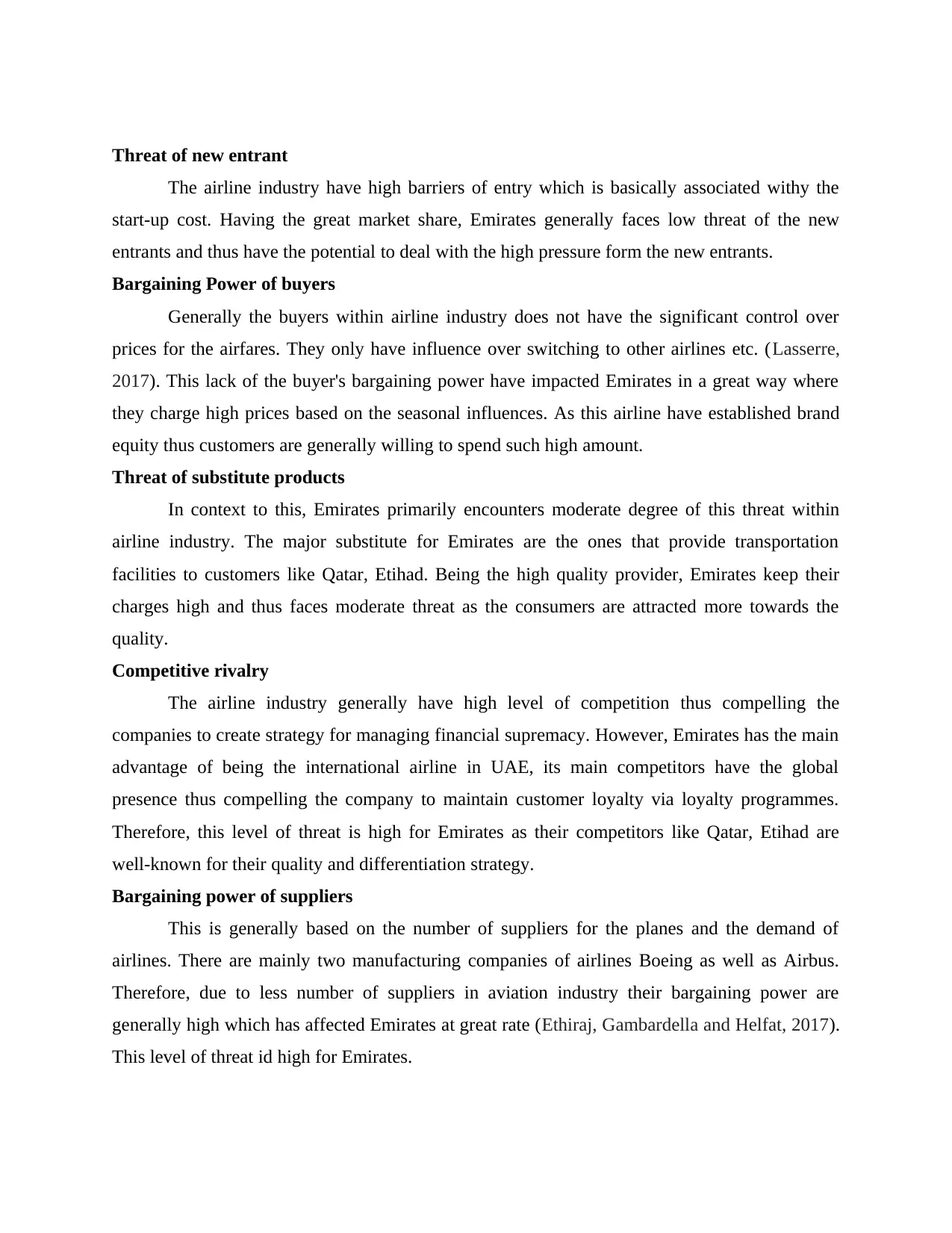
Threat of new entrant
The airline industry have high barriers of entry which is basically associated withy the
start-up cost. Having the great market share, Emirates generally faces low threat of the new
entrants and thus have the potential to deal with the high pressure form the new entrants.
Bargaining Power of buyers
Generally the buyers within airline industry does not have the significant control over
prices for the airfares. They only have influence over switching to other airlines etc. (Lasserre,
2017). This lack of the buyer's bargaining power have impacted Emirates in a great way where
they charge high prices based on the seasonal influences. As this airline have established brand
equity thus customers are generally willing to spend such high amount.
Threat of substitute products
In context to this, Emirates primarily encounters moderate degree of this threat within
airline industry. The major substitute for Emirates are the ones that provide transportation
facilities to customers like Qatar, Etihad. Being the high quality provider, Emirates keep their
charges high and thus faces moderate threat as the consumers are attracted more towards the
quality.
Competitive rivalry
The airline industry generally have high level of competition thus compelling the
companies to create strategy for managing financial supremacy. However, Emirates has the main
advantage of being the international airline in UAE, its main competitors have the global
presence thus compelling the company to maintain customer loyalty via loyalty programmes.
Therefore, this level of threat is high for Emirates as their competitors like Qatar, Etihad are
well-known for their quality and differentiation strategy.
Bargaining power of suppliers
This is generally based on the number of suppliers for the planes and the demand of
airlines. There are mainly two manufacturing companies of airlines Boeing as well as Airbus.
Therefore, due to less number of suppliers in aviation industry their bargaining power are
generally high which has affected Emirates at great rate (Ethiraj, Gambardella and Helfat, 2017).
This level of threat id high for Emirates.
The airline industry have high barriers of entry which is basically associated withy the
start-up cost. Having the great market share, Emirates generally faces low threat of the new
entrants and thus have the potential to deal with the high pressure form the new entrants.
Bargaining Power of buyers
Generally the buyers within airline industry does not have the significant control over
prices for the airfares. They only have influence over switching to other airlines etc. (Lasserre,
2017). This lack of the buyer's bargaining power have impacted Emirates in a great way where
they charge high prices based on the seasonal influences. As this airline have established brand
equity thus customers are generally willing to spend such high amount.
Threat of substitute products
In context to this, Emirates primarily encounters moderate degree of this threat within
airline industry. The major substitute for Emirates are the ones that provide transportation
facilities to customers like Qatar, Etihad. Being the high quality provider, Emirates keep their
charges high and thus faces moderate threat as the consumers are attracted more towards the
quality.
Competitive rivalry
The airline industry generally have high level of competition thus compelling the
companies to create strategy for managing financial supremacy. However, Emirates has the main
advantage of being the international airline in UAE, its main competitors have the global
presence thus compelling the company to maintain customer loyalty via loyalty programmes.
Therefore, this level of threat is high for Emirates as their competitors like Qatar, Etihad are
well-known for their quality and differentiation strategy.
Bargaining power of suppliers
This is generally based on the number of suppliers for the planes and the demand of
airlines. There are mainly two manufacturing companies of airlines Boeing as well as Airbus.
Therefore, due to less number of suppliers in aviation industry their bargaining power are
generally high which has affected Emirates at great rate (Ethiraj, Gambardella and Helfat, 2017).
This level of threat id high for Emirates.
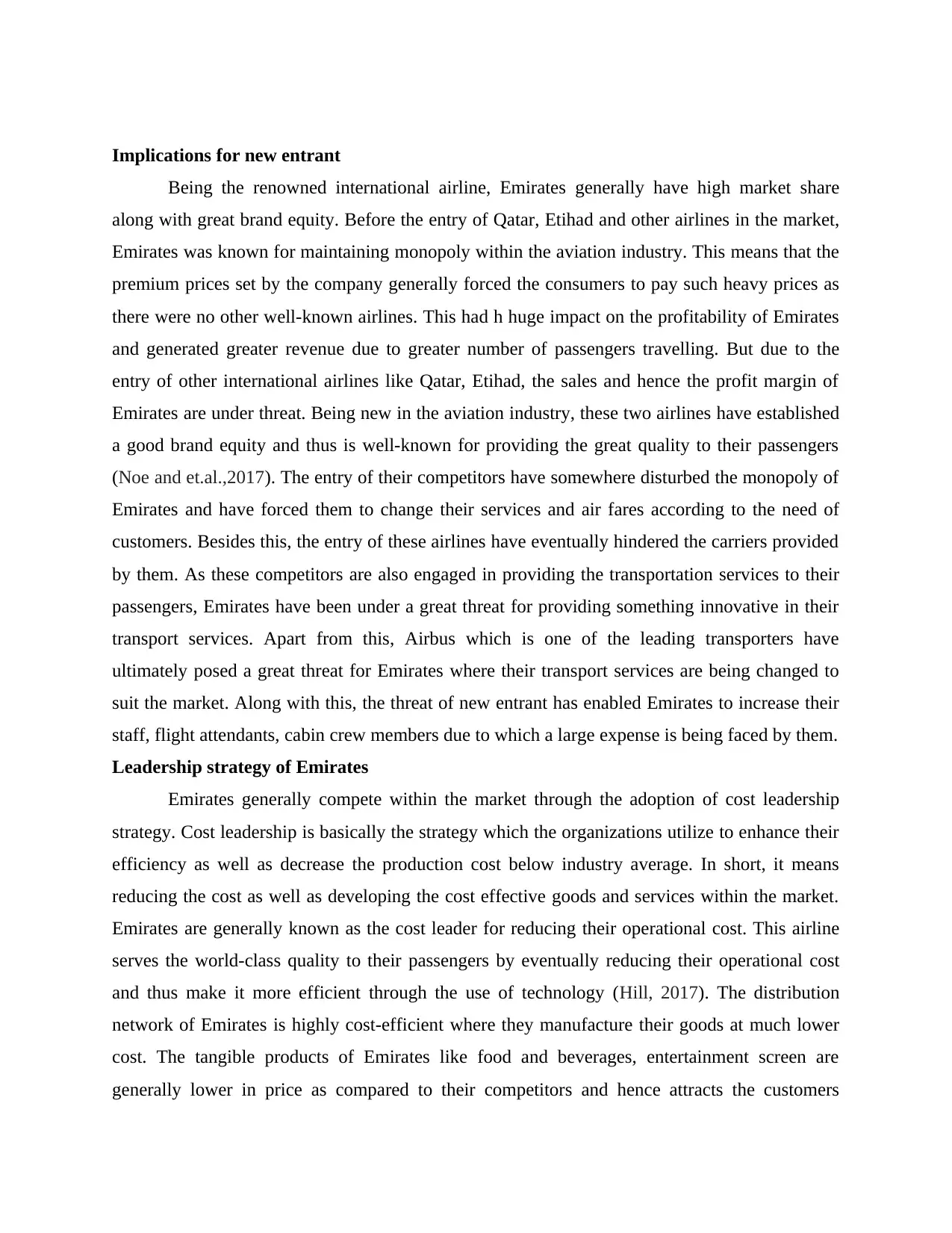
Implications for new entrant
Being the renowned international airline, Emirates generally have high market share
along with great brand equity. Before the entry of Qatar, Etihad and other airlines in the market,
Emirates was known for maintaining monopoly within the aviation industry. This means that the
premium prices set by the company generally forced the consumers to pay such heavy prices as
there were no other well-known airlines. This had h huge impact on the profitability of Emirates
and generated greater revenue due to greater number of passengers travelling. But due to the
entry of other international airlines like Qatar, Etihad, the sales and hence the profit margin of
Emirates are under threat. Being new in the aviation industry, these two airlines have established
a good brand equity and thus is well-known for providing the great quality to their passengers
(Noe and et.al.,2017). The entry of their competitors have somewhere disturbed the monopoly of
Emirates and have forced them to change their services and air fares according to the need of
customers. Besides this, the entry of these airlines have eventually hindered the carriers provided
by them. As these competitors are also engaged in providing the transportation services to their
passengers, Emirates have been under a great threat for providing something innovative in their
transport services. Apart from this, Airbus which is one of the leading transporters have
ultimately posed a great threat for Emirates where their transport services are being changed to
suit the market. Along with this, the threat of new entrant has enabled Emirates to increase their
staff, flight attendants, cabin crew members due to which a large expense is being faced by them.
Leadership strategy of Emirates
Emirates generally compete within the market through the adoption of cost leadership
strategy. Cost leadership is basically the strategy which the organizations utilize to enhance their
efficiency as well as decrease the production cost below industry average. In short, it means
reducing the cost as well as developing the cost effective goods and services within the market.
Emirates are generally known as the cost leader for reducing their operational cost. This airline
serves the world-class quality to their passengers by eventually reducing their operational cost
and thus make it more efficient through the use of technology (Hill, 2017). The distribution
network of Emirates is highly cost-efficient where they manufacture their goods at much lower
cost. The tangible products of Emirates like food and beverages, entertainment screen are
generally lower in price as compared to their competitors and hence attracts the customers
Being the renowned international airline, Emirates generally have high market share
along with great brand equity. Before the entry of Qatar, Etihad and other airlines in the market,
Emirates was known for maintaining monopoly within the aviation industry. This means that the
premium prices set by the company generally forced the consumers to pay such heavy prices as
there were no other well-known airlines. This had h huge impact on the profitability of Emirates
and generated greater revenue due to greater number of passengers travelling. But due to the
entry of other international airlines like Qatar, Etihad, the sales and hence the profit margin of
Emirates are under threat. Being new in the aviation industry, these two airlines have established
a good brand equity and thus is well-known for providing the great quality to their passengers
(Noe and et.al.,2017). The entry of their competitors have somewhere disturbed the monopoly of
Emirates and have forced them to change their services and air fares according to the need of
customers. Besides this, the entry of these airlines have eventually hindered the carriers provided
by them. As these competitors are also engaged in providing the transportation services to their
passengers, Emirates have been under a great threat for providing something innovative in their
transport services. Apart from this, Airbus which is one of the leading transporters have
ultimately posed a great threat for Emirates where their transport services are being changed to
suit the market. Along with this, the threat of new entrant has enabled Emirates to increase their
staff, flight attendants, cabin crew members due to which a large expense is being faced by them.
Leadership strategy of Emirates
Emirates generally compete within the market through the adoption of cost leadership
strategy. Cost leadership is basically the strategy which the organizations utilize to enhance their
efficiency as well as decrease the production cost below industry average. In short, it means
reducing the cost as well as developing the cost effective goods and services within the market.
Emirates are generally known as the cost leader for reducing their operational cost. This airline
serves the world-class quality to their passengers by eventually reducing their operational cost
and thus make it more efficient through the use of technology (Hill, 2017). The distribution
network of Emirates is highly cost-efficient where they manufacture their goods at much lower
cost. The tangible products of Emirates like food and beverages, entertainment screen are
generally lower in price as compared to their competitors and hence attracts the customers
Paraphrase This Document
Need a fresh take? Get an instant paraphrase of this document with our AI Paraphraser
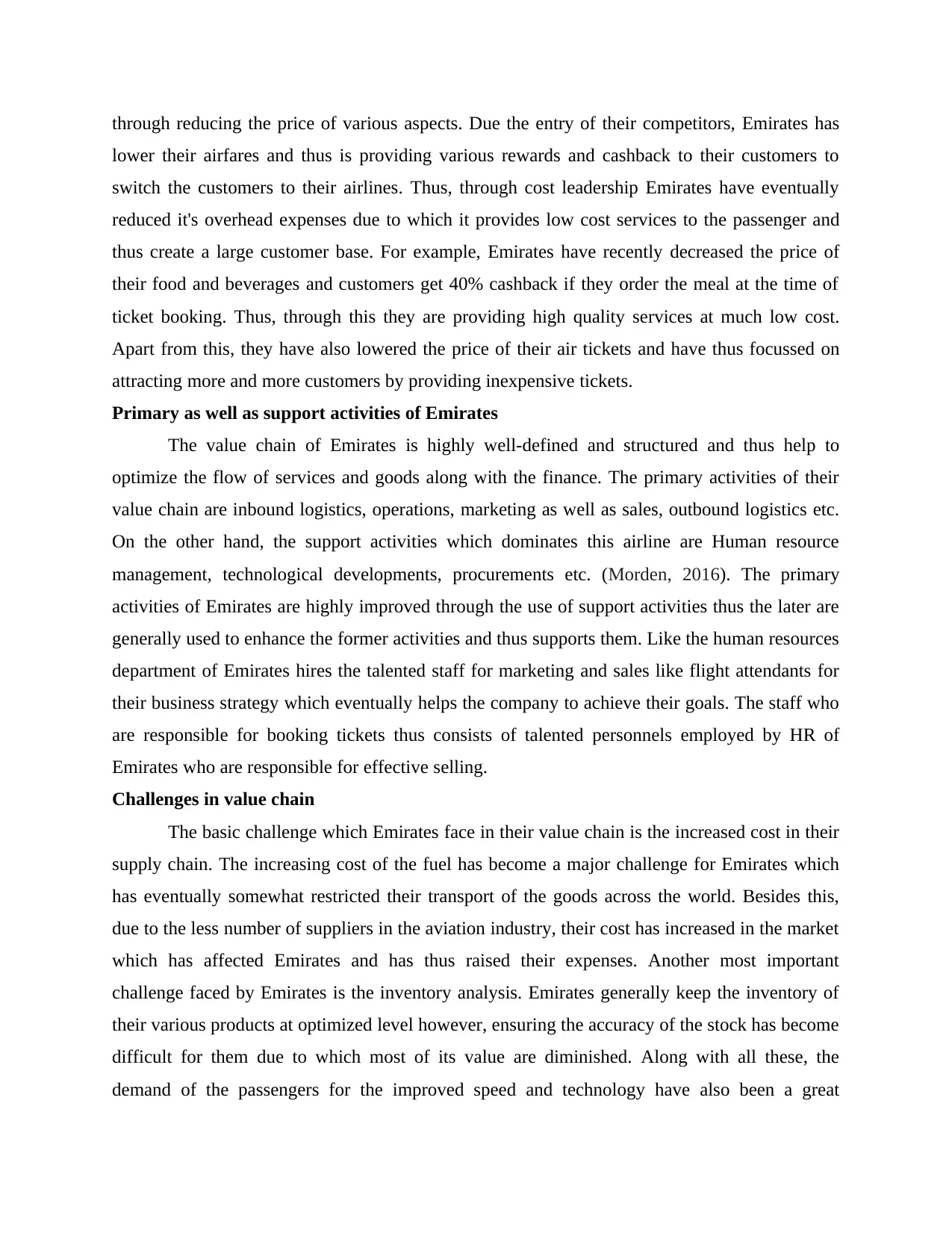
through reducing the price of various aspects. Due the entry of their competitors, Emirates has
lower their airfares and thus is providing various rewards and cashback to their customers to
switch the customers to their airlines. Thus, through cost leadership Emirates have eventually
reduced it's overhead expenses due to which it provides low cost services to the passenger and
thus create a large customer base. For example, Emirates have recently decreased the price of
their food and beverages and customers get 40% cashback if they order the meal at the time of
ticket booking. Thus, through this they are providing high quality services at much low cost.
Apart from this, they have also lowered the price of their air tickets and have thus focussed on
attracting more and more customers by providing inexpensive tickets.
Primary as well as support activities of Emirates
The value chain of Emirates is highly well-defined and structured and thus help to
optimize the flow of services and goods along with the finance. The primary activities of their
value chain are inbound logistics, operations, marketing as well as sales, outbound logistics etc.
On the other hand, the support activities which dominates this airline are Human resource
management, technological developments, procurements etc. (Morden, 2016). The primary
activities of Emirates are highly improved through the use of support activities thus the later are
generally used to enhance the former activities and thus supports them. Like the human resources
department of Emirates hires the talented staff for marketing and sales like flight attendants for
their business strategy which eventually helps the company to achieve their goals. The staff who
are responsible for booking tickets thus consists of talented personnels employed by HR of
Emirates who are responsible for effective selling.
Challenges in value chain
The basic challenge which Emirates face in their value chain is the increased cost in their
supply chain. The increasing cost of the fuel has become a major challenge for Emirates which
has eventually somewhat restricted their transport of the goods across the world. Besides this,
due to the less number of suppliers in the aviation industry, their cost has increased in the market
which has affected Emirates and has thus raised their expenses. Another most important
challenge faced by Emirates is the inventory analysis. Emirates generally keep the inventory of
their various products at optimized level however, ensuring the accuracy of the stock has become
difficult for them due to which most of its value are diminished. Along with all these, the
demand of the passengers for the improved speed and technology have also been a great
lower their airfares and thus is providing various rewards and cashback to their customers to
switch the customers to their airlines. Thus, through cost leadership Emirates have eventually
reduced it's overhead expenses due to which it provides low cost services to the passenger and
thus create a large customer base. For example, Emirates have recently decreased the price of
their food and beverages and customers get 40% cashback if they order the meal at the time of
ticket booking. Thus, through this they are providing high quality services at much low cost.
Apart from this, they have also lowered the price of their air tickets and have thus focussed on
attracting more and more customers by providing inexpensive tickets.
Primary as well as support activities of Emirates
The value chain of Emirates is highly well-defined and structured and thus help to
optimize the flow of services and goods along with the finance. The primary activities of their
value chain are inbound logistics, operations, marketing as well as sales, outbound logistics etc.
On the other hand, the support activities which dominates this airline are Human resource
management, technological developments, procurements etc. (Morden, 2016). The primary
activities of Emirates are highly improved through the use of support activities thus the later are
generally used to enhance the former activities and thus supports them. Like the human resources
department of Emirates hires the talented staff for marketing and sales like flight attendants for
their business strategy which eventually helps the company to achieve their goals. The staff who
are responsible for booking tickets thus consists of talented personnels employed by HR of
Emirates who are responsible for effective selling.
Challenges in value chain
The basic challenge which Emirates face in their value chain is the increased cost in their
supply chain. The increasing cost of the fuel has become a major challenge for Emirates which
has eventually somewhat restricted their transport of the goods across the world. Besides this,
due to the less number of suppliers in the aviation industry, their cost has increased in the market
which has affected Emirates and has thus raised their expenses. Another most important
challenge faced by Emirates is the inventory analysis. Emirates generally keep the inventory of
their various products at optimized level however, ensuring the accuracy of the stock has become
difficult for them due to which most of its value are diminished. Along with all these, the
demand of the passengers for the improved speed and technology have also been a great
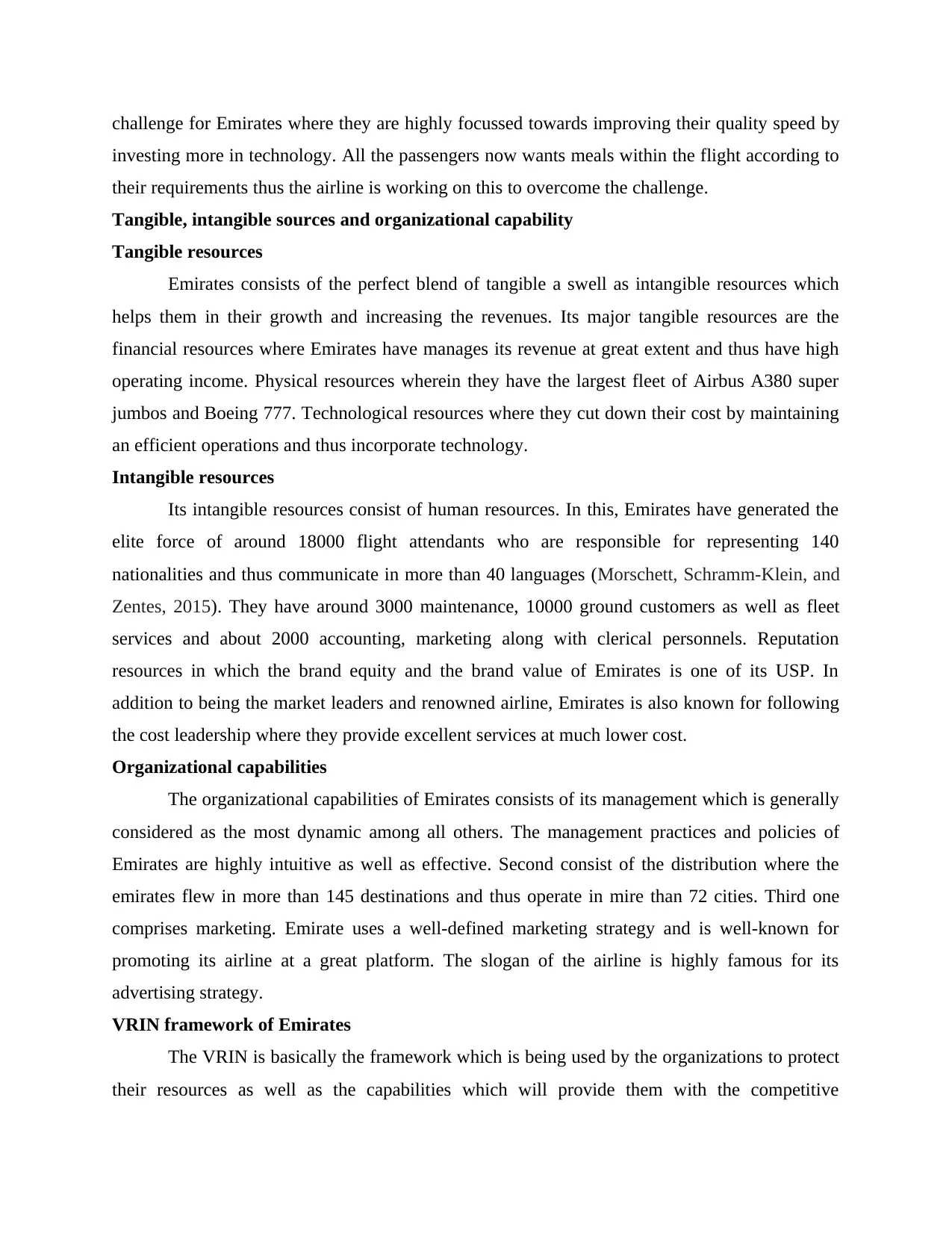
challenge for Emirates where they are highly focussed towards improving their quality speed by
investing more in technology. All the passengers now wants meals within the flight according to
their requirements thus the airline is working on this to overcome the challenge.
Tangible, intangible sources and organizational capability
Tangible resources
Emirates consists of the perfect blend of tangible a swell as intangible resources which
helps them in their growth and increasing the revenues. Its major tangible resources are the
financial resources where Emirates have manages its revenue at great extent and thus have high
operating income. Physical resources wherein they have the largest fleet of Airbus A380 super
jumbos and Boeing 777. Technological resources where they cut down their cost by maintaining
an efficient operations and thus incorporate technology.
Intangible resources
Its intangible resources consist of human resources. In this, Emirates have generated the
elite force of around 18000 flight attendants who are responsible for representing 140
nationalities and thus communicate in more than 40 languages (Morschett, Schramm-Klein, and
Zentes, 2015). They have around 3000 maintenance, 10000 ground customers as well as fleet
services and about 2000 accounting, marketing along with clerical personnels. Reputation
resources in which the brand equity and the brand value of Emirates is one of its USP. In
addition to being the market leaders and renowned airline, Emirates is also known for following
the cost leadership where they provide excellent services at much lower cost.
Organizational capabilities
The organizational capabilities of Emirates consists of its management which is generally
considered as the most dynamic among all others. The management practices and policies of
Emirates are highly intuitive as well as effective. Second consist of the distribution where the
emirates flew in more than 145 destinations and thus operate in mire than 72 cities. Third one
comprises marketing. Emirate uses a well-defined marketing strategy and is well-known for
promoting its airline at a great platform. The slogan of the airline is highly famous for its
advertising strategy.
VRIN framework of Emirates
The VRIN is basically the framework which is being used by the organizations to protect
their resources as well as the capabilities which will provide them with the competitive
investing more in technology. All the passengers now wants meals within the flight according to
their requirements thus the airline is working on this to overcome the challenge.
Tangible, intangible sources and organizational capability
Tangible resources
Emirates consists of the perfect blend of tangible a swell as intangible resources which
helps them in their growth and increasing the revenues. Its major tangible resources are the
financial resources where Emirates have manages its revenue at great extent and thus have high
operating income. Physical resources wherein they have the largest fleet of Airbus A380 super
jumbos and Boeing 777. Technological resources where they cut down their cost by maintaining
an efficient operations and thus incorporate technology.
Intangible resources
Its intangible resources consist of human resources. In this, Emirates have generated the
elite force of around 18000 flight attendants who are responsible for representing 140
nationalities and thus communicate in more than 40 languages (Morschett, Schramm-Klein, and
Zentes, 2015). They have around 3000 maintenance, 10000 ground customers as well as fleet
services and about 2000 accounting, marketing along with clerical personnels. Reputation
resources in which the brand equity and the brand value of Emirates is one of its USP. In
addition to being the market leaders and renowned airline, Emirates is also known for following
the cost leadership where they provide excellent services at much lower cost.
Organizational capabilities
The organizational capabilities of Emirates consists of its management which is generally
considered as the most dynamic among all others. The management practices and policies of
Emirates are highly intuitive as well as effective. Second consist of the distribution where the
emirates flew in more than 145 destinations and thus operate in mire than 72 cities. Third one
comprises marketing. Emirate uses a well-defined marketing strategy and is well-known for
promoting its airline at a great platform. The slogan of the airline is highly famous for its
advertising strategy.
VRIN framework of Emirates
The VRIN is basically the framework which is being used by the organizations to protect
their resources as well as the capabilities which will provide them with the competitive
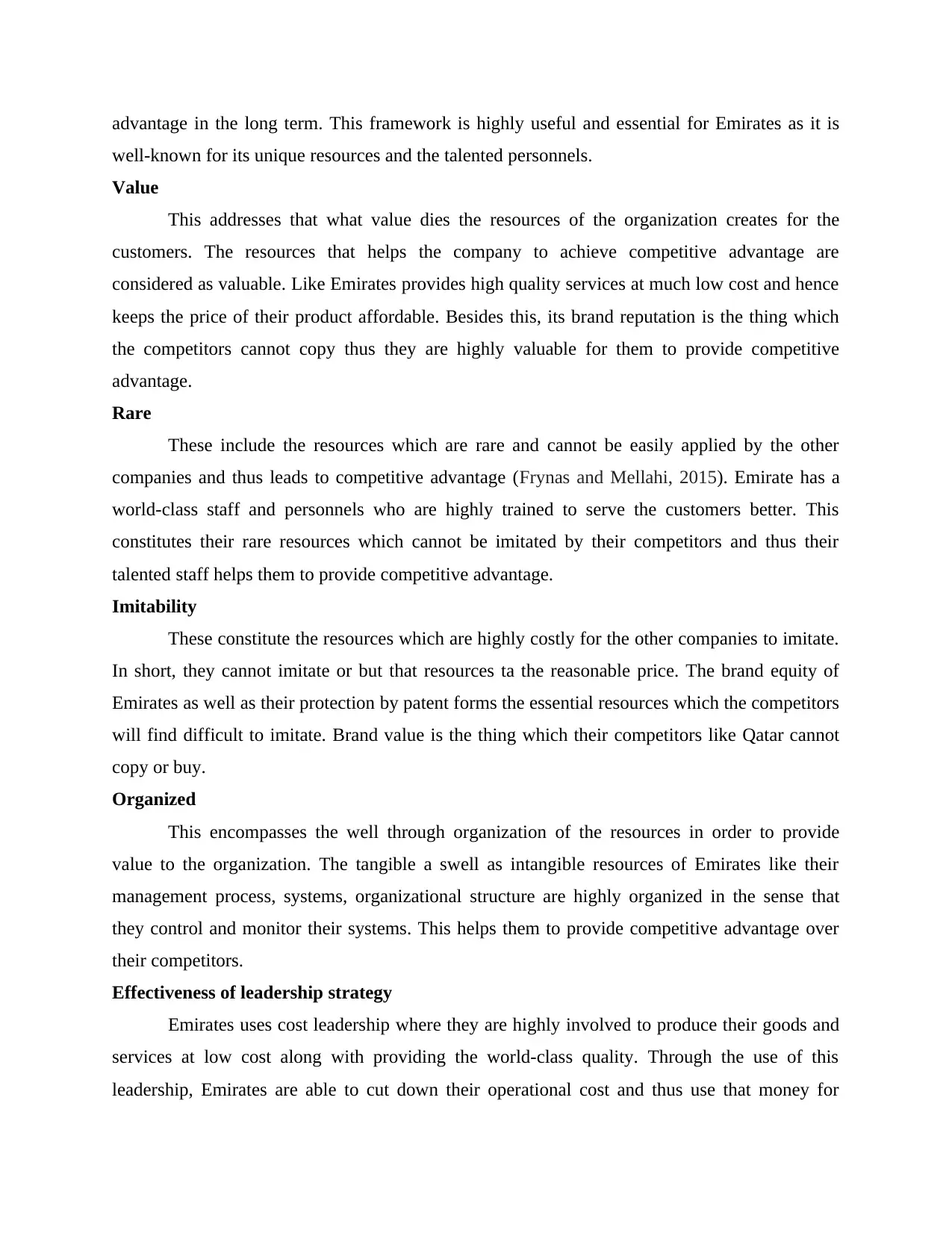
advantage in the long term. This framework is highly useful and essential for Emirates as it is
well-known for its unique resources and the talented personnels.
Value
This addresses that what value dies the resources of the organization creates for the
customers. The resources that helps the company to achieve competitive advantage are
considered as valuable. Like Emirates provides high quality services at much low cost and hence
keeps the price of their product affordable. Besides this, its brand reputation is the thing which
the competitors cannot copy thus they are highly valuable for them to provide competitive
advantage.
Rare
These include the resources which are rare and cannot be easily applied by the other
companies and thus leads to competitive advantage (Frynas and Mellahi, 2015). Emirate has a
world-class staff and personnels who are highly trained to serve the customers better. This
constitutes their rare resources which cannot be imitated by their competitors and thus their
talented staff helps them to provide competitive advantage.
Imitability
These constitute the resources which are highly costly for the other companies to imitate.
In short, they cannot imitate or but that resources ta the reasonable price. The brand equity of
Emirates as well as their protection by patent forms the essential resources which the competitors
will find difficult to imitate. Brand value is the thing which their competitors like Qatar cannot
copy or buy.
Organized
This encompasses the well through organization of the resources in order to provide
value to the organization. The tangible a swell as intangible resources of Emirates like their
management process, systems, organizational structure are highly organized in the sense that
they control and monitor their systems. This helps them to provide competitive advantage over
their competitors.
Effectiveness of leadership strategy
Emirates uses cost leadership where they are highly involved to produce their goods and
services at low cost along with providing the world-class quality. Through the use of this
leadership, Emirates are able to cut down their operational cost and thus use that money for
well-known for its unique resources and the talented personnels.
Value
This addresses that what value dies the resources of the organization creates for the
customers. The resources that helps the company to achieve competitive advantage are
considered as valuable. Like Emirates provides high quality services at much low cost and hence
keeps the price of their product affordable. Besides this, its brand reputation is the thing which
the competitors cannot copy thus they are highly valuable for them to provide competitive
advantage.
Rare
These include the resources which are rare and cannot be easily applied by the other
companies and thus leads to competitive advantage (Frynas and Mellahi, 2015). Emirate has a
world-class staff and personnels who are highly trained to serve the customers better. This
constitutes their rare resources which cannot be imitated by their competitors and thus their
talented staff helps them to provide competitive advantage.
Imitability
These constitute the resources which are highly costly for the other companies to imitate.
In short, they cannot imitate or but that resources ta the reasonable price. The brand equity of
Emirates as well as their protection by patent forms the essential resources which the competitors
will find difficult to imitate. Brand value is the thing which their competitors like Qatar cannot
copy or buy.
Organized
This encompasses the well through organization of the resources in order to provide
value to the organization. The tangible a swell as intangible resources of Emirates like their
management process, systems, organizational structure are highly organized in the sense that
they control and monitor their systems. This helps them to provide competitive advantage over
their competitors.
Effectiveness of leadership strategy
Emirates uses cost leadership where they are highly involved to produce their goods and
services at low cost along with providing the world-class quality. Through the use of this
leadership, Emirates are able to cut down their operational cost and thus use that money for
Secure Best Marks with AI Grader
Need help grading? Try our AI Grader for instant feedback on your assignments.
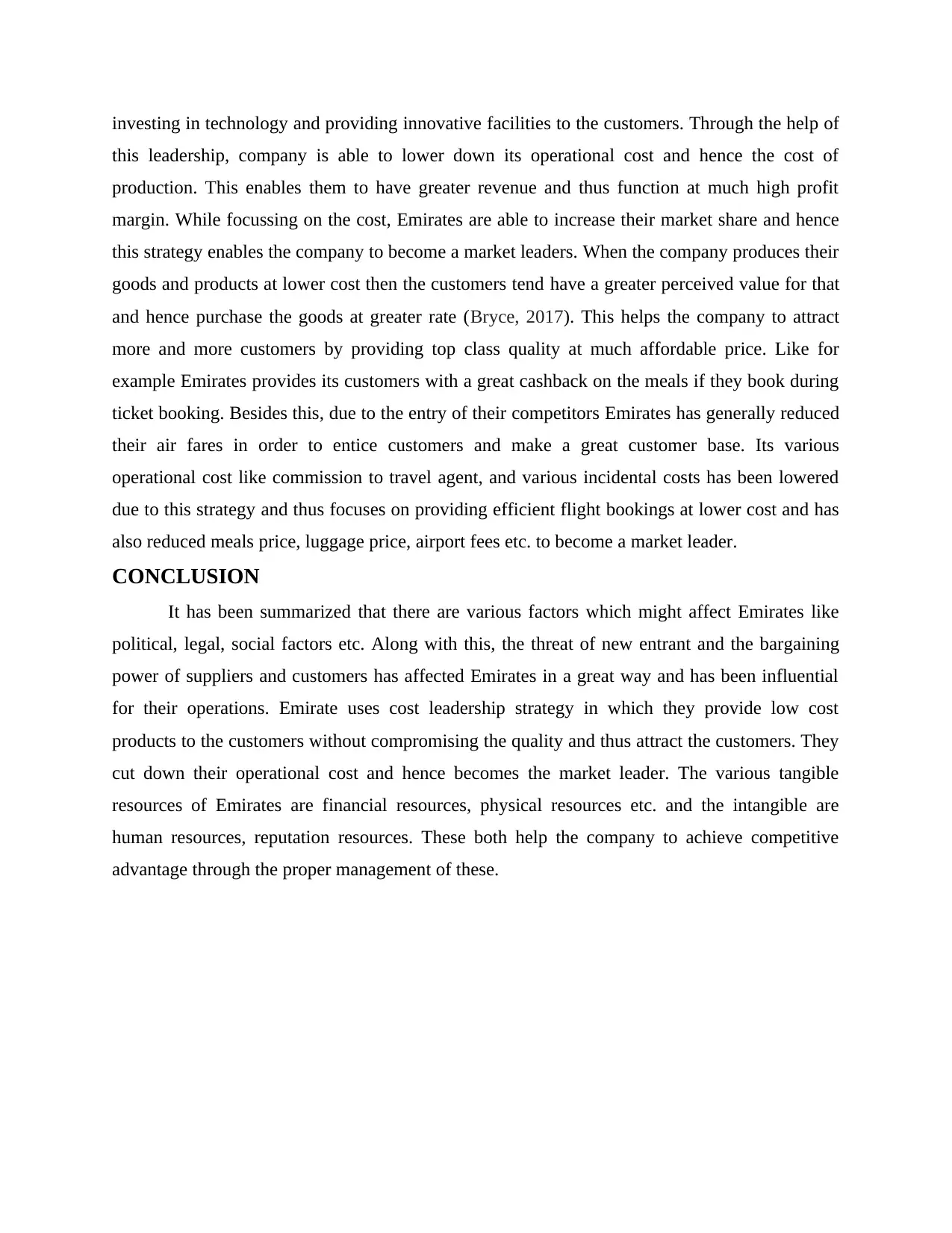
investing in technology and providing innovative facilities to the customers. Through the help of
this leadership, company is able to lower down its operational cost and hence the cost of
production. This enables them to have greater revenue and thus function at much high profit
margin. While focussing on the cost, Emirates are able to increase their market share and hence
this strategy enables the company to become a market leaders. When the company produces their
goods and products at lower cost then the customers tend have a greater perceived value for that
and hence purchase the goods at greater rate (Bryce, 2017). This helps the company to attract
more and more customers by providing top class quality at much affordable price. Like for
example Emirates provides its customers with a great cashback on the meals if they book during
ticket booking. Besides this, due to the entry of their competitors Emirates has generally reduced
their air fares in order to entice customers and make a great customer base. Its various
operational cost like commission to travel agent, and various incidental costs has been lowered
due to this strategy and thus focuses on providing efficient flight bookings at lower cost and has
also reduced meals price, luggage price, airport fees etc. to become a market leader.
CONCLUSION
It has been summarized that there are various factors which might affect Emirates like
political, legal, social factors etc. Along with this, the threat of new entrant and the bargaining
power of suppliers and customers has affected Emirates in a great way and has been influential
for their operations. Emirate uses cost leadership strategy in which they provide low cost
products to the customers without compromising the quality and thus attract the customers. They
cut down their operational cost and hence becomes the market leader. The various tangible
resources of Emirates are financial resources, physical resources etc. and the intangible are
human resources, reputation resources. These both help the company to achieve competitive
advantage through the proper management of these.
this leadership, company is able to lower down its operational cost and hence the cost of
production. This enables them to have greater revenue and thus function at much high profit
margin. While focussing on the cost, Emirates are able to increase their market share and hence
this strategy enables the company to become a market leaders. When the company produces their
goods and products at lower cost then the customers tend have a greater perceived value for that
and hence purchase the goods at greater rate (Bryce, 2017). This helps the company to attract
more and more customers by providing top class quality at much affordable price. Like for
example Emirates provides its customers with a great cashback on the meals if they book during
ticket booking. Besides this, due to the entry of their competitors Emirates has generally reduced
their air fares in order to entice customers and make a great customer base. Its various
operational cost like commission to travel agent, and various incidental costs has been lowered
due to this strategy and thus focuses on providing efficient flight bookings at lower cost and has
also reduced meals price, luggage price, airport fees etc. to become a market leader.
CONCLUSION
It has been summarized that there are various factors which might affect Emirates like
political, legal, social factors etc. Along with this, the threat of new entrant and the bargaining
power of suppliers and customers has affected Emirates in a great way and has been influential
for their operations. Emirate uses cost leadership strategy in which they provide low cost
products to the customers without compromising the quality and thus attract the customers. They
cut down their operational cost and hence becomes the market leader. The various tangible
resources of Emirates are financial resources, physical resources etc. and the intangible are
human resources, reputation resources. These both help the company to achieve competitive
advantage through the proper management of these.
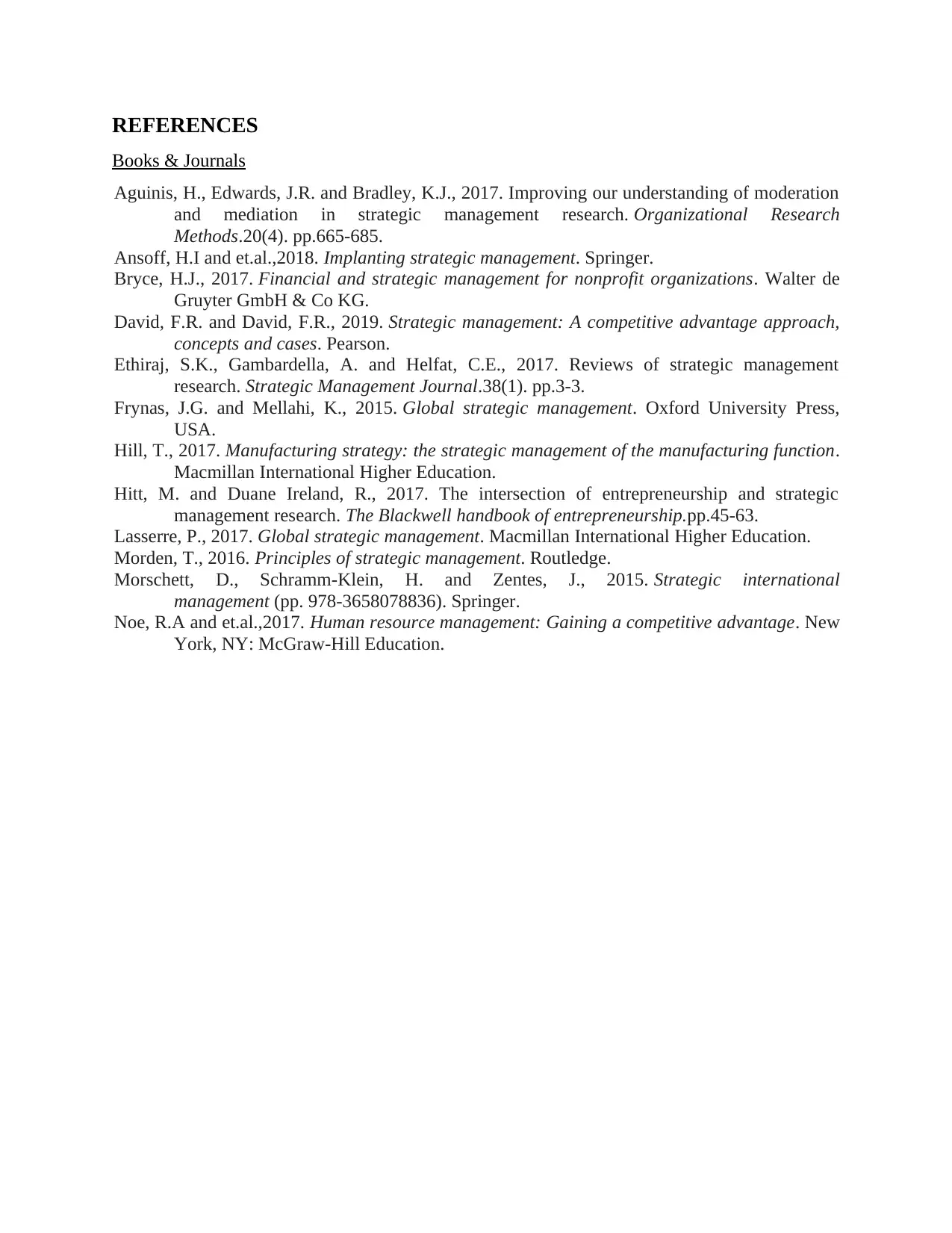
REFERENCES
Books & Journals
Aguinis, H., Edwards, J.R. and Bradley, K.J., 2017. Improving our understanding of moderation
and mediation in strategic management research. Organizational Research
Methods.20(4). pp.665-685.
Ansoff, H.I and et.al.,2018. Implanting strategic management. Springer.
Bryce, H.J., 2017. Financial and strategic management for nonprofit organizations. Walter de
Gruyter GmbH & Co KG.
David, F.R. and David, F.R., 2019. Strategic management: A competitive advantage approach,
concepts and cases. Pearson.
Ethiraj, S.K., Gambardella, A. and Helfat, C.E., 2017. Reviews of strategic management
research. Strategic Management Journal.38(1). pp.3-3.
Frynas, J.G. and Mellahi, K., 2015. Global strategic management. Oxford University Press,
USA.
Hill, T., 2017. Manufacturing strategy: the strategic management of the manufacturing function.
Macmillan International Higher Education.
Hitt, M. and Duane Ireland, R., 2017. The intersection of entrepreneurship and strategic
management research. The Blackwell handbook of entrepreneurship.pp.45-63.
Lasserre, P., 2017. Global strategic management. Macmillan International Higher Education.
Morden, T., 2016. Principles of strategic management. Routledge.
Morschett, D., Schramm-Klein, H. and Zentes, J., 2015. Strategic international
management (pp. 978-3658078836). Springer.
Noe, R.A and et.al.,2017. Human resource management: Gaining a competitive advantage. New
York, NY: McGraw-Hill Education.
Books & Journals
Aguinis, H., Edwards, J.R. and Bradley, K.J., 2017. Improving our understanding of moderation
and mediation in strategic management research. Organizational Research
Methods.20(4). pp.665-685.
Ansoff, H.I and et.al.,2018. Implanting strategic management. Springer.
Bryce, H.J., 2017. Financial and strategic management for nonprofit organizations. Walter de
Gruyter GmbH & Co KG.
David, F.R. and David, F.R., 2019. Strategic management: A competitive advantage approach,
concepts and cases. Pearson.
Ethiraj, S.K., Gambardella, A. and Helfat, C.E., 2017. Reviews of strategic management
research. Strategic Management Journal.38(1). pp.3-3.
Frynas, J.G. and Mellahi, K., 2015. Global strategic management. Oxford University Press,
USA.
Hill, T., 2017. Manufacturing strategy: the strategic management of the manufacturing function.
Macmillan International Higher Education.
Hitt, M. and Duane Ireland, R., 2017. The intersection of entrepreneurship and strategic
management research. The Blackwell handbook of entrepreneurship.pp.45-63.
Lasserre, P., 2017. Global strategic management. Macmillan International Higher Education.
Morden, T., 2016. Principles of strategic management. Routledge.
Morschett, D., Schramm-Klein, H. and Zentes, J., 2015. Strategic international
management (pp. 978-3658078836). Springer.
Noe, R.A and et.al.,2017. Human resource management: Gaining a competitive advantage. New
York, NY: McGraw-Hill Education.

Paraphrase This Document
Need a fresh take? Get an instant paraphrase of this document with our AI Paraphraser



1 out of 16
Related Documents
Your All-in-One AI-Powered Toolkit for Academic Success.
+13062052269
info@desklib.com
Available 24*7 on WhatsApp / Email
![[object Object]](/_next/static/media/star-bottom.7253800d.svg)
Unlock your academic potential
© 2024 | Zucol Services PVT LTD | All rights reserved.





